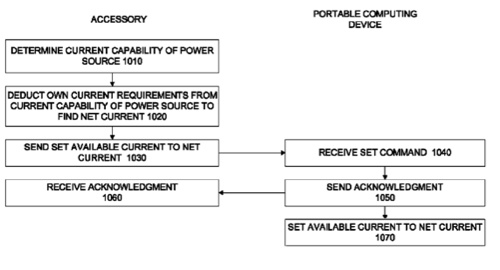An Apple patent (number 8069356) for accessory power management has appeared at the US Patent & Trademark Office. It includes methods, apparatus, and circuits for managing power among portable computing devices and one or more accessories.
One example provides commands to improve power management between a portable computing device and one or more accessories. Other examples provide commands that may allow a portable computing device to charge at a maximum available current level while providing an accessory with sufficient current for its proper operation. Another may help prevent a portable computing device from drawing a high level of current that could be detrimental to an accessory, while others provide commands that may allow a battery pack to instruct a portable computing device to not charge its internal battery.
Another example may allow a portable computing device to determine which power supply among multiple power supplies should be used to power an accessory, while others may allow an accessory to retrieve charging current parameters from a portable computing device. The inventors are Shailesh Rathi, Lawrence G. Bolton, John Ananny and Scott Krueger.
Here’s Apple’s background on the invention: “The popularity of various portable electronic devices has exploded the past several years and the public’s fascination and desire for new devices shows no signs of abating. Along with this increase in popularity, the number of types of these portable devices has grown considerably, and the functionality of these devices has diversified tremendously.
“Interestingly, this diversification has become so thorough that it has begun to lead to a convergence. One such convergence is occurring with portable computing devices.
“Smaller devices, such as phones, can now be used to perform functions that were previously limited to larger computing devices. These go beyond native functions, such as actually calling people, and include listening to music, watching movies, viewing documents, surfing the web, and reading email. Larger devices, such as netbooks, are slimming down to ultraportable size by jettisoning their optical drives and other functionality.
“The evolution of these devices is thus converging towards a common destination: the portable computing device. These portable computing devices may handle various functions currently assigned to phones and netbooks. They may be used to listen to music, watch movies, view and edit documents, surf the web, read email and books, as well as myriad other functions.
“Users of these portable computing devices often place them in a docking station. These docking stations may provide mechanical support for the portable computing devices, holding them in place in a roughly upright manner so that the screen can be viewed easily. Other accessories may be used with these portable computing devices as well. These accessories often provide power to the portable computing device, which is used to run circuitry on the portable computing device and to charge its internal battery.
“These portable computing devices have comparatively large batteries and a correspondingly large current is required to charge them. But while the portable computing device’s batteries are charging, the accessories require current for their operation. Also, some accessories may only be able to safely supply a certain amount of current. Thus, what is needed are methods, apparatus, and circuits for managing power among these portable computing devices and one or more accessories.”
— Dennis Sellers

